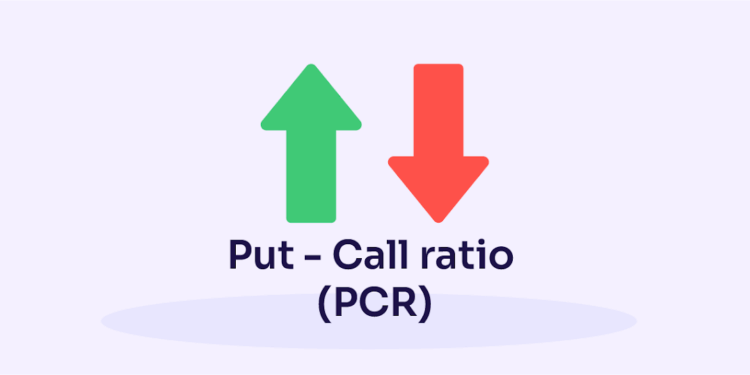Investing in the stock market is often perceived as a complex endeavour, primarily due to the plethora of metrics and analytics involved. Among these metrics, the PCR Ratio often garners significant attention for its ability to provide insights into market sentiment. As investors seek to decipher the intricacies of the stock market, understanding PCR Ratio becomes crucial. A comprehensive understanding of this ratio, alongside other ratios like P/E Ratio, can aid in making informed decisions. This article delves into the essence of PCR Ratio, presenting essential calculations and insights in INR, while ensuring the insights provided can arm you with valuable knowledge for your investment journey.
Understanding PCR Ratio
The PCR Ratio, or Put-Call Ratio, is a popular metric that gauges investor sentiment through the comparison of the trading volume of put options versus call options. In simpler terms, it measures how many put options are being purchased compared to call options, offering insights into whether the overall sentiment in the market is bullish or bearish. Generally, a higher PCR indicates a bearish sentiment, while a lower PCR indicates bullish sentiment.
Calculating PCR Ratio
The calculation of the PCR Ratio is straightforward:
PCR Ratio = Number of Put Contracts / Number of Call Contracts
For example, if the number of put options traded is 15,000 and the number of call options traded is 25,000, the PCR Ratio would be:
PCR Ratio = 15,000 / 25,000 = 0.6
This PCR Ratio of 0.6 indicates a relatively bullish market sentiment, as there are more call options being purchased than put options.
Importance of PCR Ratio
The PCR Ratio serves multiple purposes:
1. Sentiment Analysis
It acts as a sentiment indicator, showing whether investors might be anticipating upward or downward movement in the market.
2. Market Timing
Traders sometimes use PCR Ratios to decide entry and exit points for trades by assessing whether the market is overbought or oversold.
3. Risk Assessment
By understanding the prevailing sentiment, investors can assess risk. A very high PCR might suggest caution, while a very low PCR might suggest optimism.
PCR in Strategic Investments
While PCR is a useful indicator, it is essential to integrate it into a broader strategic outlook. The ratio must be used alongside other financial metrics such as the P/E Ratio to develop a well-rounded investment strategy.
The Role of P/E Ratio in Investments
The Price-to-Earnings (P/E) Ratio is a fundamental tool in evaluating a company’s stock value. It is calculated using the following formula:
P/E Ratio = Market Value per Share / Earnings per Share
For example, if a company’s stock is trading at INR 500 per share and its EPS is INR 50, the P/E Ratio is:
P/E Ratio = 500 / 50 = 10
This P/E Ratio of 10 suggests that investors are willing to pay 10 times the earnings per share, providing a gauge for valuing the stock against peers and industry standards.
Integrating PCR and P/E Ratio for a Holistic Approach
Using PCR in conjunction with P/E Ratio creates a more comprehensive investment strategy. While PCR provides insights into market sentiment, P/E Ratio offers a perspective on the valuation and fundamentals of individual stocks.
1. Cross-Referencing Trends
If the PCR Ratio indicates bearish sentiment, but the P/E Ratio is low, it might suggest potential undervaluation opportunities.
2. Diverging Signals
Conversely, a bullish PCR combined with a high P/E Ratio could indicate inflated market expectations, signalling caution.
A Holistic Perspective to Investment Decision-Making
When contemplating investments, it is indispensable to consider the entire spectrum of financial indicators. Integrated analyses not only encompass PCR and P/E Ratios but also metrics such as debt-to-equity ratios, return on equity (ROE), and broader economic indicators.
Moreover, macroeconomic factors, industry trends, and geopolitical events also play vital roles in shaping market conditions. Investors should remain aware of these aspects when making decisions.
Conclusion
In conclusion, the PCR Ratio is an influential tool in assessing market sentiment and forms part of a more extensive analytical arsenal necessary for prudent investment decision-making. While understanding the PCR Ratio offers insights into market trends, combining it with secondary metrics such as the P/E Ratio allows investors to examine the market with a more nuanced approach.
It bears emphasis that successful investing demands patience, strategic planning, and an informed viewpoint. Every market analysis tool offers a piece of the puzzle, and PCR is no exception. Still, investors should regard these analytics as guides rather than guarantees.
Disclaimer
The information provided here is for educational purposes only and does not constitute financial advice. Investing in the stock market involves risks, and investors should gauge all pros and cons of trading in the Indian stock market. Personal due diligence and consultation with financial experts are recommended to tailor decisions to individual circumstances and investment objectives.
By learning the PCR Ratio, integrating it with other ratios like the P/E Ratio, and considering broader financial and market dynamics, investors can ease their investment processes. While no single metric can predict market outcomes, a holistic approach can better equip investors for navigating the complexities of the financial landscape.







